Effects of the Wavelength for the Sinusoidal Cylinder and Reynolds Number for Three-Dimensional Mixed Convection
Abstract
:1. Introduction
2. Numerical Simulation
2.1. Numerical Methods
2.2. Problem Description
3. Results
3.1. Bifurcation Map
3.2. Thermal and Flow Structures
3.3. Unsteady Characteristics
3.4. Nusselt Number
4. Conclusions
Author Contributions
Funding
Data Availability Statement
Acknowledgments
Conflicts of Interest
Nomenclature
| Symbols | |
| fi | Momentum forcing |
| g | Acceleration of gravity |
| L | Characteristics length |
| n | Normal direction to the wall |
| Nu | Local Nusselt number |
| <Nu> | Surface-averaged Nusselt number |
| Time-averaged Nusselt number | |
| <> | Time- and surface-averaged Nusselt number |
| P | Dimensionless pressure |
| Pr | Prandtl number, ν/α |
| q | Mass source and sink |
| Re | Reynolds number, UrefL/ν |
| S3C | Steady three-dimensional convection |
| t | Dimensionless time |
| ui | Dimensionless velocity |
| U3C | Unsteady three-dimensional convection |
| W | Surface area of walls |
| xi | Dimensionless Cartesian coordinates |
| Greek symbols | |
| α | Thermal diffusivity |
| β | Thermal expansion coefficient |
| δi2 | Kronecker delta |
| ρ | Density |
| ν | Kinematic viscosity |
| θ | Dimensionless temperature |
| Superscripts/Subscripts | |
| * | Dimensional value |
| B | Bottom wall |
| c | Cold |
| Cyl | Cylinder |
| En | Enclosure |
| h | Hot |
References
- Ozoe, H.; Yamamoto, K.; Churchill, S.W.; Sayama, H. Three-dimensional, numerical analysis of laminar natural convection in a confined fluid heat from below. J. Heat Transf. 1976, 98, 202–207. [Google Scholar] [CrossRef]
- Busse, F.H.; Clever, R.M. Instabilities of convection rolls in a fluid of moderate Prandtl number. J. Fluid Mech. 1979, 91, 319–335. [Google Scholar] [CrossRef]
- Hartlep, T.; Tilgner, A.; Busse, F.H. Transition to turbulent convection in a fluid layer heated from below at moderate aspect ratio. J. Fluid Mech. 2005, 554, 309–322. [Google Scholar] [CrossRef]
- Choi, C.; Ha, M.Y.; Yoon, H.S. Characteristics of Rayleigh-Bénard convection in a rectangular channel with an inner hot circular cylinder. J. Heat Transf. 2015, 137, 112501. [Google Scholar] [CrossRef]
- Seo, Y.M.; Ha, M.Y.; Park, Y.G. A numerical study on the three-dimensional natural convection with a cylinder in a long rectangular enclosure. Part I: Size effect of a circular cylinder or an elliptical cylinder. Int. J. Heat Mass Transf. 2019, 134, 420–436. [Google Scholar] [CrossRef]
- Iwatsu, R.; Hyun, J.M.; Kuwahara, K. Mixed convection in a driven cavity with a stable vertical temperature gradient. Int. J. Heat Mass Transf. 1993, 36, 1601–1608. [Google Scholar] [CrossRef]
- Sivakumar, V.; Sivasankaran, S.; Prakash, P.; Lee, J. Effect of heating location and size on mixed convection in lid-driven cavities. Comput. Math. Appl. 2010, 59, 3053–3065. [Google Scholar] [CrossRef] [Green Version]
- Sharif, M.A.R. Laminar mixed convection in shallow inclined driven cavities with hot moving lid on top and cooled from bottom. Appl. Therm. Eng. 2007, 27, 1036–1042. [Google Scholar] [CrossRef]
- Shi, X.; Khodadadi, J.M. Laminar Fluid Flow and Heat Transfer in a Lid-Driven Cavity Due to a Thin Fin. J. Heat Transf. 2002, 124, 1056–1063. [Google Scholar] [CrossRef]
- Oztop, H.F.; Zhao, Z.; Yu, B. Fluid flow due to combined convection in lid-driven enclosure having a circular body. Int. J. Heat Fluid Flow 2009, 30, 886–901. [Google Scholar] [CrossRef]
- Islam, A.W.; Sharif, M.A.R.; Carlson, E.R. Mixed convection in a lid driven square cavity with an isothermally heated square blockage inside. Int. J. Heat Mass Transf. 2012, 55, 5244–5255. [Google Scholar] [CrossRef]
- Liao, C.C.; Lin, C.A. Influences of a confined elliptic cylinder at different aspect ratio and inclinations on the laminar natural and mixed convection flows. Int. J. Heat Mass Transf. 2012, 55, 6638–6650. [Google Scholar] [CrossRef]
- Gangawane, K.M. Computational analysis of mixed convection heat transfer characteristics in lid-driven cavity containing triangular block with constant heat flux: Effect of Prandtl and Grashof numbers. Int. J. Heat Mass Transf. 2017, 105, 34–57. [Google Scholar] [CrossRef]
- Gupta, S.K.; Chatterjee, D.; Mondal, B. Invetigation of mixed convection in a ventilated cavity in the presence of a heat conducting circular cylinder. Numer. Heat Tranf. Part A Appl. 2015, 67, 52–74. [Google Scholar] [CrossRef]
- Billah, M.M.; Rahman, M.M.; Sharif, U.M.; Rahim, N.A.; Saidur, R.; Hasanuzzaman, M. Numerical analysis of fluid flow due to mixed convection in a lid-driven cavity having a heated circular hollow cylinder. Int. Commun. Heat Mass Transf. 2011, 38, 1093–1103. [Google Scholar] [CrossRef]
- Khanafer, K.; Aithal, S.M. Laminar mixed convection flow and heat transfer characteristics in a lid driven cavity with a circular cylinder. Int. J. Heat Mass Transf. 2013, 66, 200–209. [Google Scholar] [CrossRef]
- Iwatsu, R.; Hyun, J.M. Three-dimensional drive-cavity flows with a vertical temperature gradient. Int. J. Heat Mass Transf. 1995, 38, 3319–3328. [Google Scholar] [CrossRef]
- Ouertatani, N.; Cheikh, N.B.; Beya, B.B.; Lili, T.; Campo, A. Mixed convection in a double lid-drive cubic cavity. Int. J. Therm. Sci. 2009, 48, 1265–1272. [Google Scholar] [CrossRef]
- Cho, H.W.; Park, Y.G.; Seo, Y.M.; Ha, M.Y. Three-Dimensional Mixed Convection in a Rectangular Enclosure Containing a Circular Cylinder. Heat Transf. Eng. 2022, 43, 879–895. [Google Scholar] [CrossRef]
- Cho, H.W.; Seo, Y.M.; Park, Y.G.; Pandey, S.; Ha, M.Y. Estimation of heat transfer performance on mixed convection in an enclosure with an inner cylinder using an artificial neural network. Case Stud. Therm. Eng. 2021, 28, 101595. [Google Scholar] [CrossRef]
- Kim, J.; Kim, D.; Choi, H. An immersed-boundary finite volume method for simulations of flow in complex geometries. J. Comput. Phys. 2001, 171, 132–150. [Google Scholar] [CrossRef]
- Kim, J.; Choi, H. An immersed-boundary finite-volume method for simulation of heat transfer in complex geometries. KSME Int. J. 2004, 18, 1026–1035. [Google Scholar] [CrossRef]
- Choi, C. A Numerical Study of the Effect of a Circular Cylinder on Natural Convection in Rectangular Channel Heated from Bottom Wall. Ph.D. Thesis, Pusan National University, Busan, Republic of Korea, 2014; pp. 1–171. [Google Scholar]
- Choi, H.; Moin, P. Effects of the computational time step on numerical solutions of turbulent flow. J. Comput. Phys. 1994, 113, 1–4. [Google Scholar] [CrossRef]
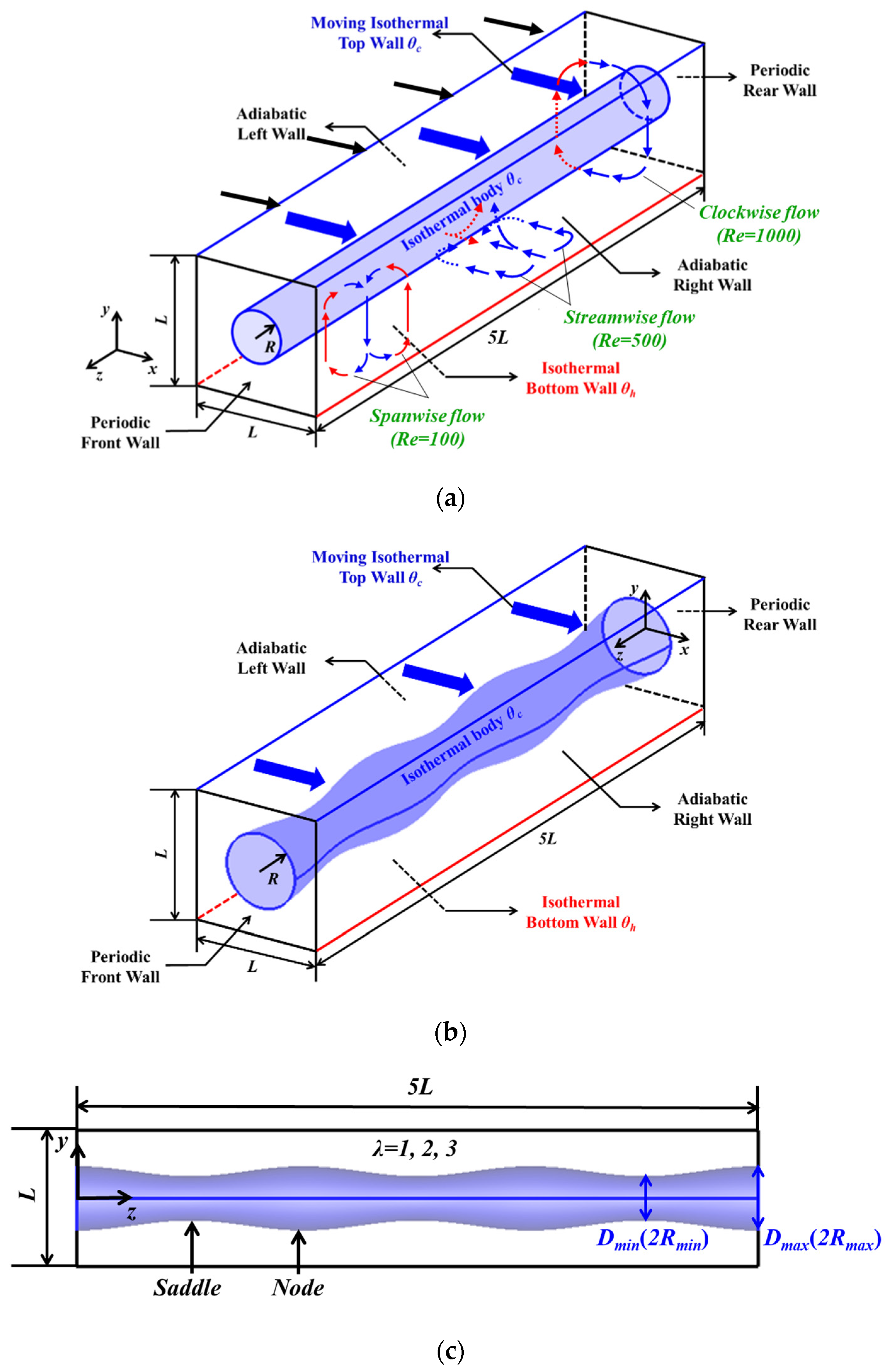
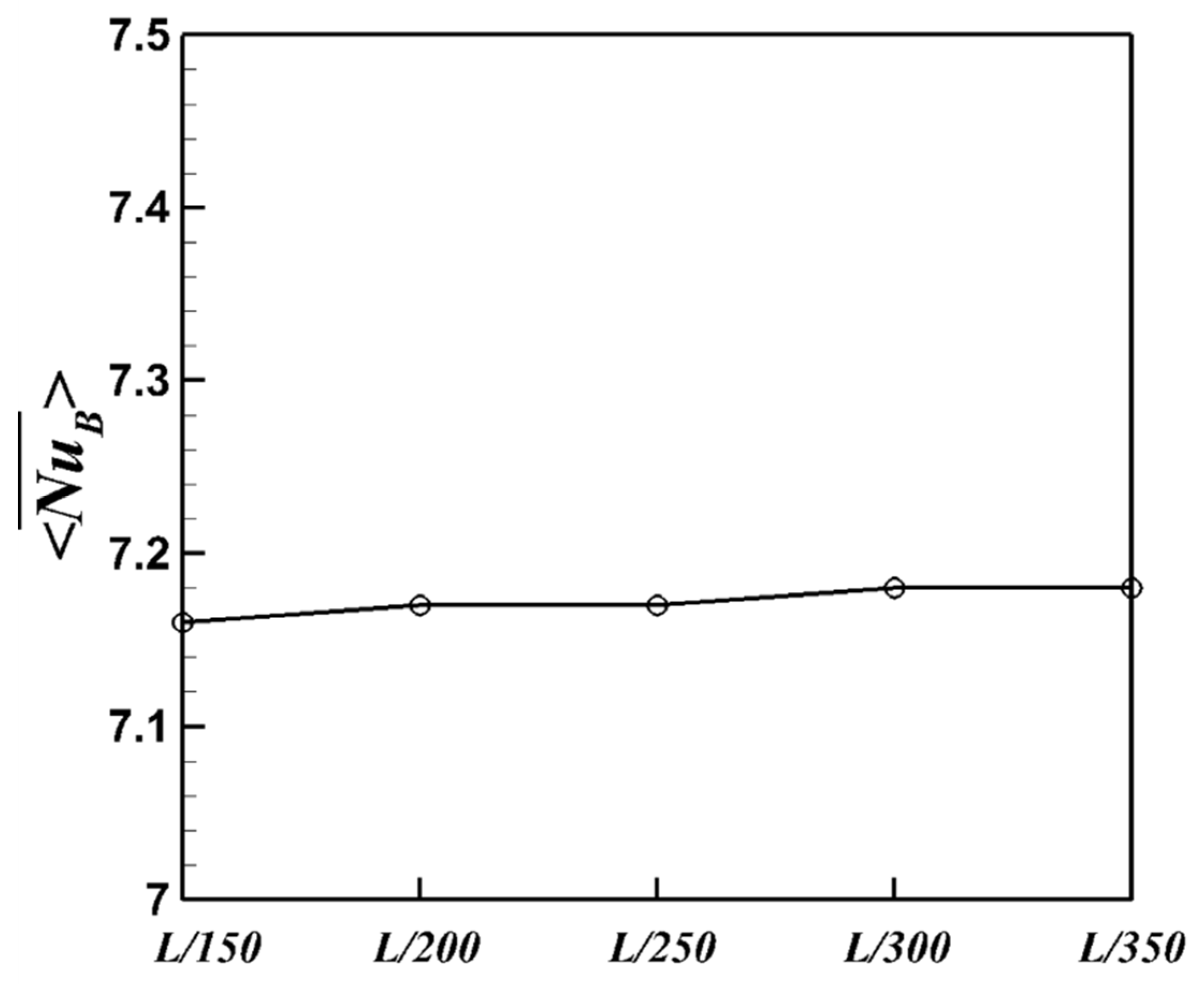
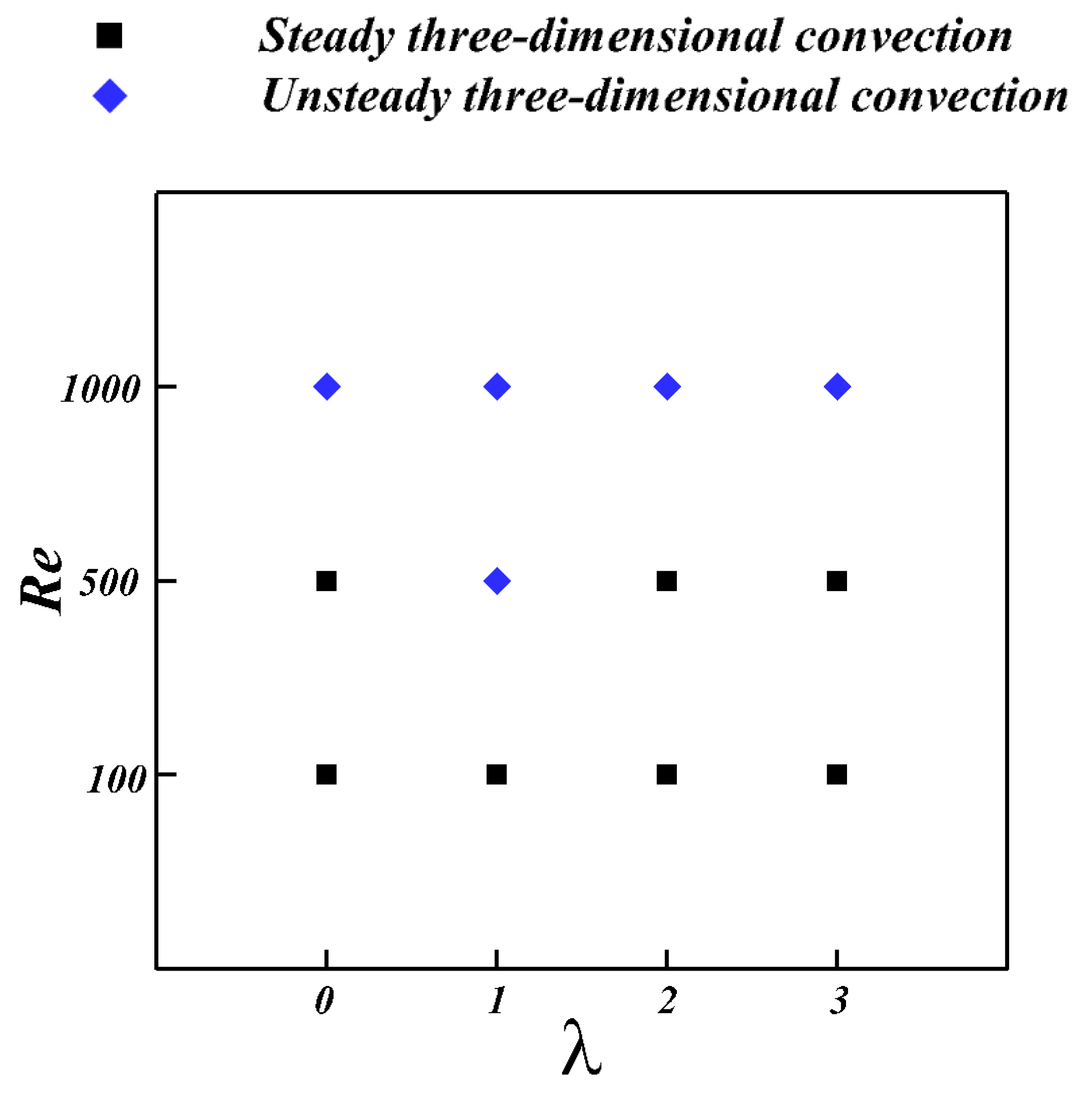
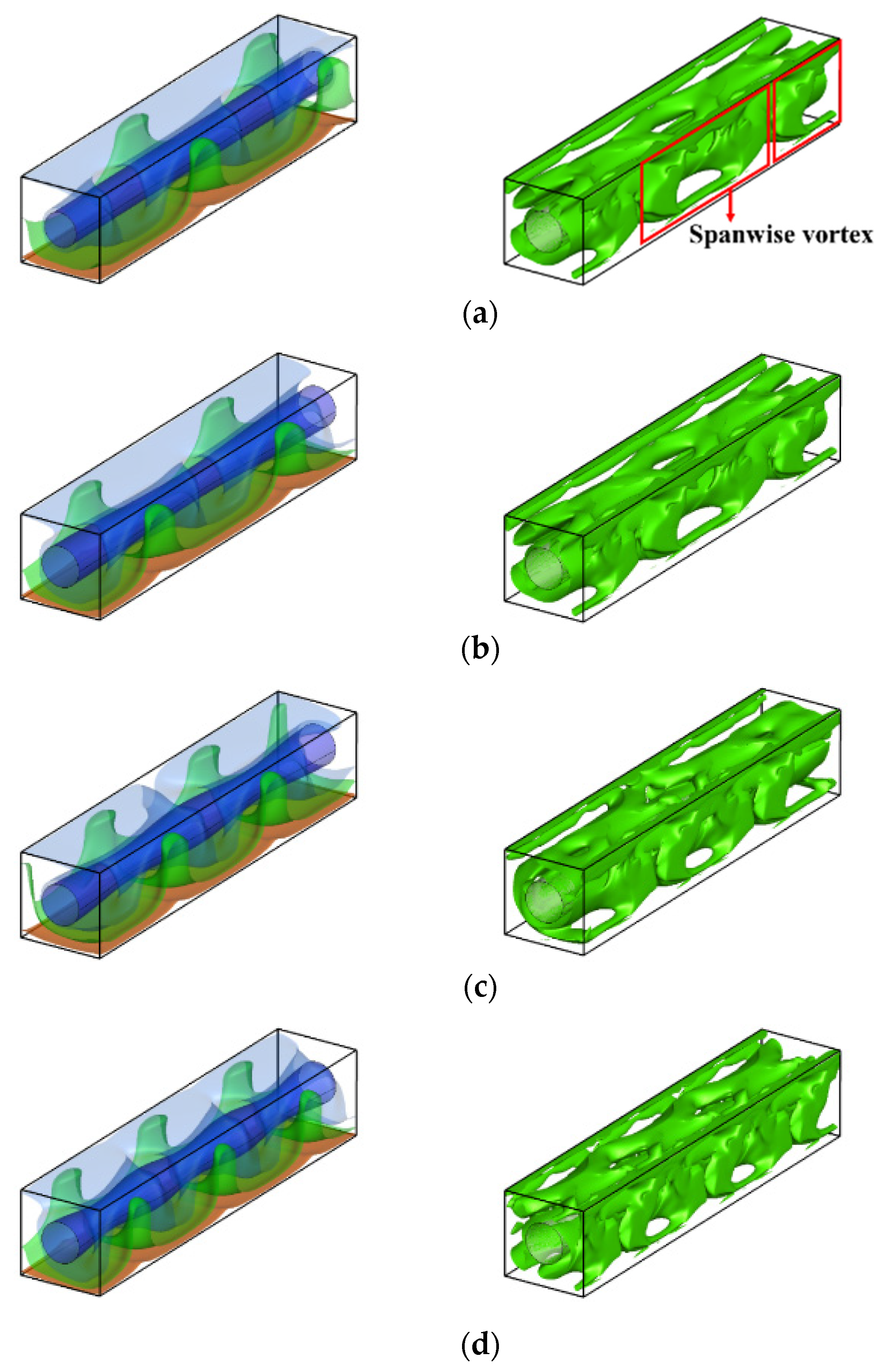


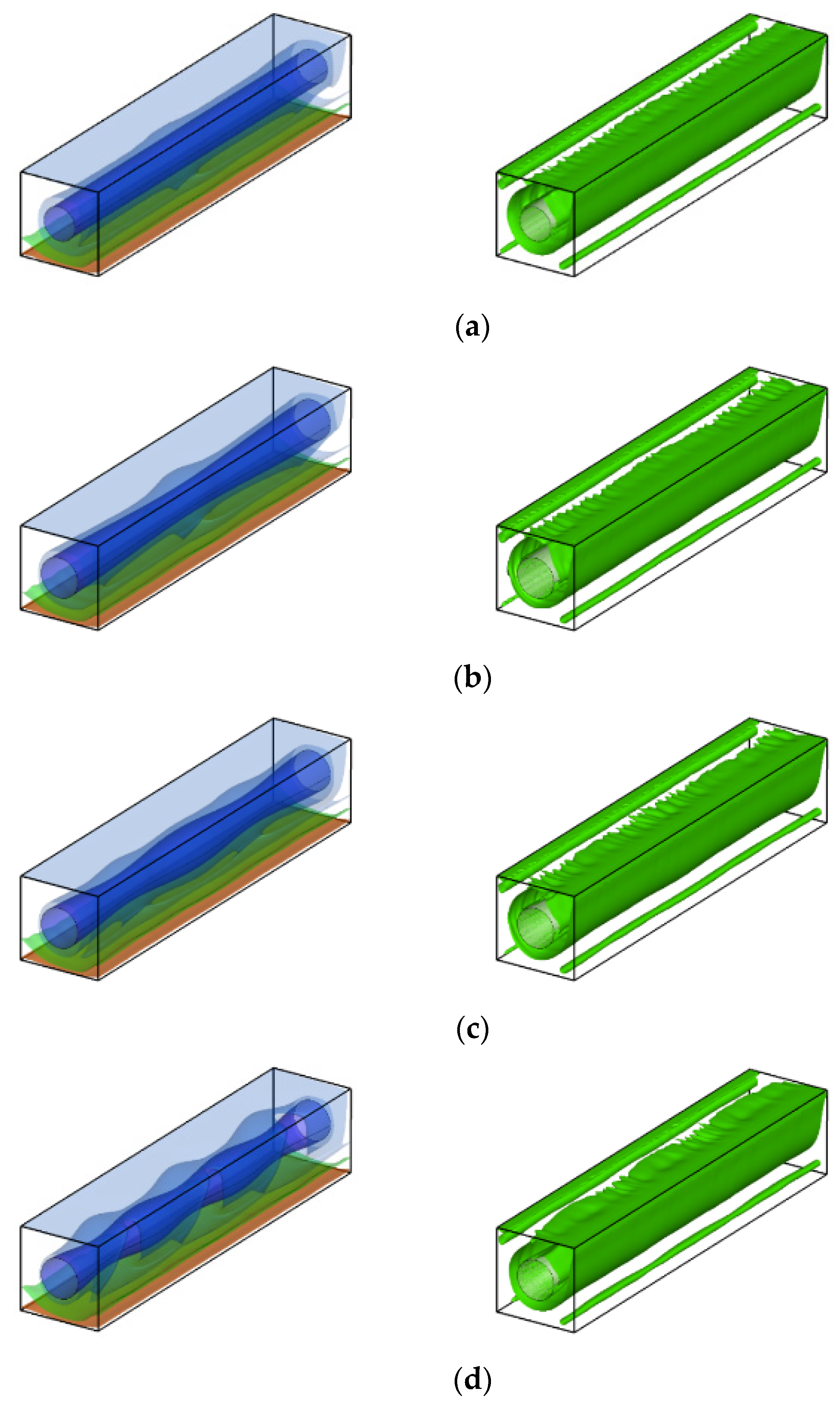
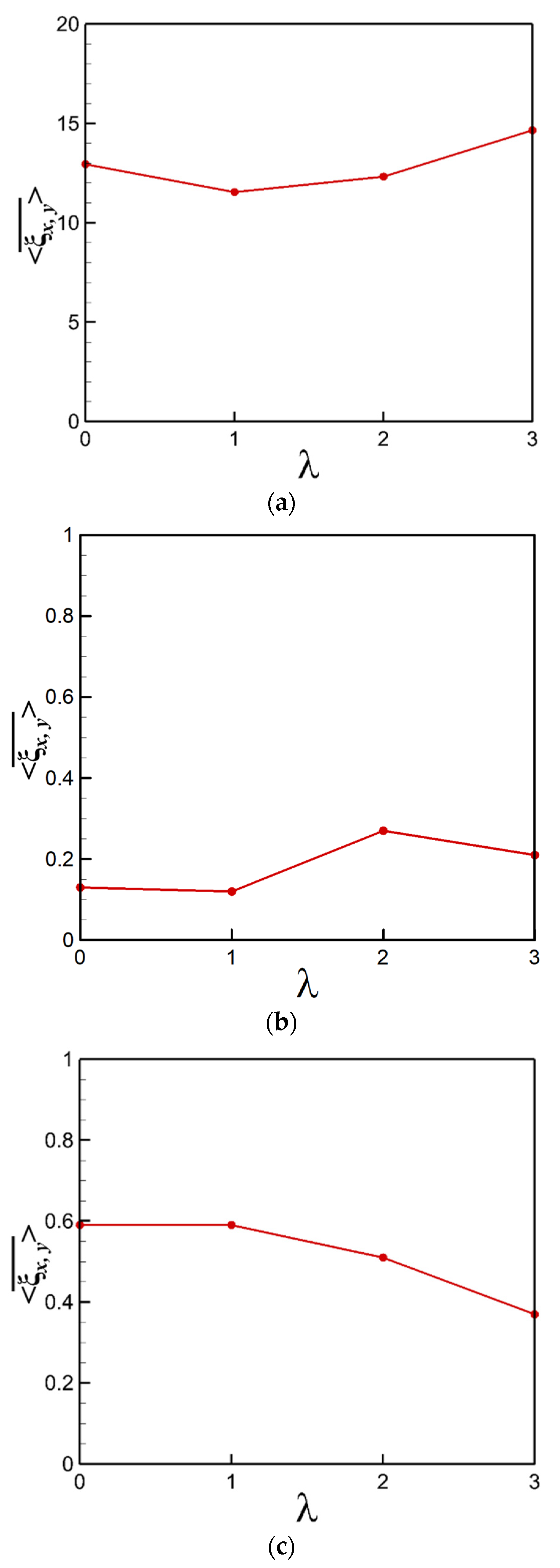
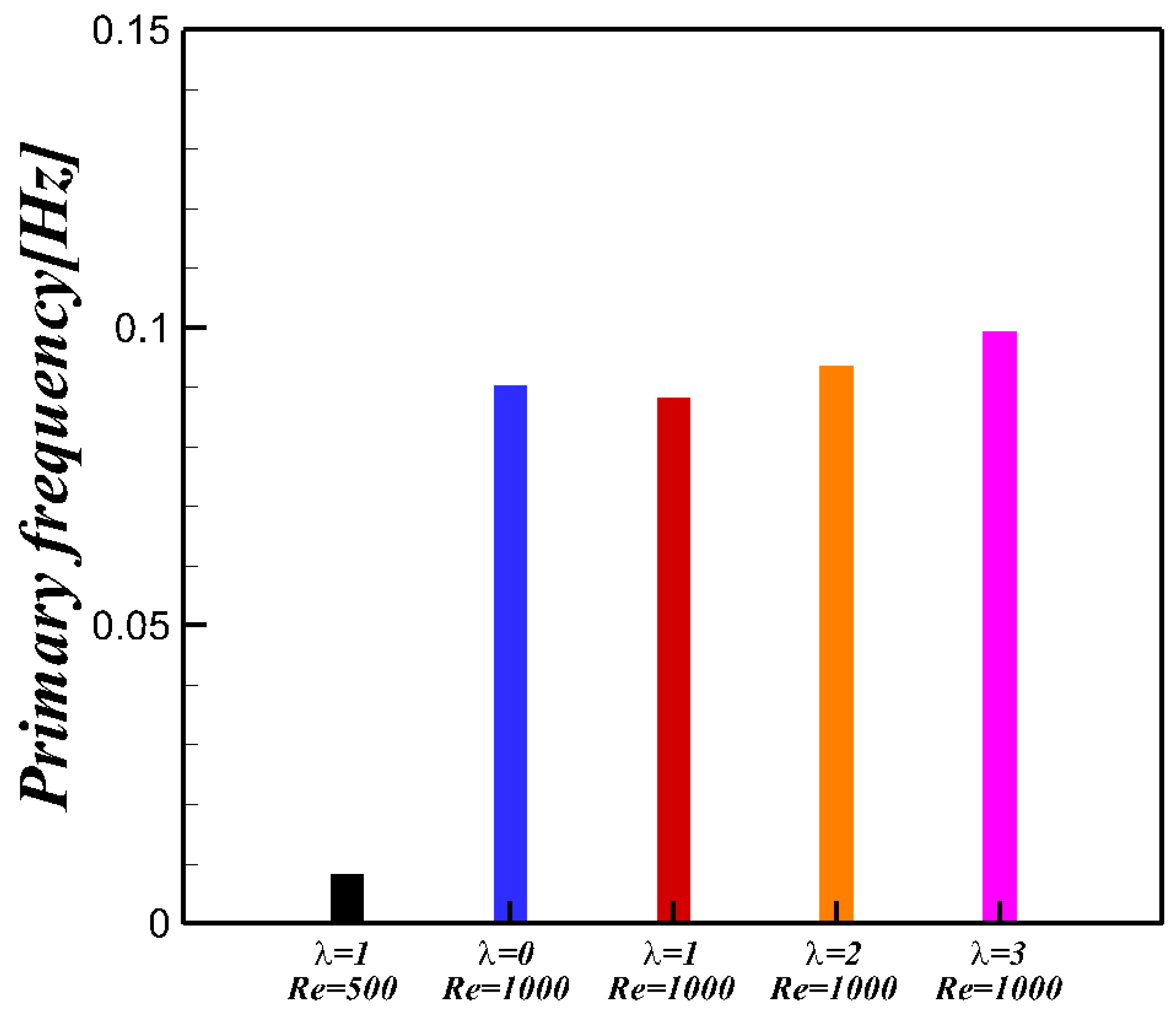

| Grashof Number | Numean | Error (%) | |
| [16] | Present | ||
| 10 | 1.838 | 1.814 | 1.29 |
| 104 | 1.705 | 1.676 | 1.71 |
| 105 | 1.204 | 1.257 | 4.39 |
| Grashof Number | Numean | Error (%) | |
| [18] | Present | ||
| 102 | 2.92 | 2.95 | 1.0 |
| 104 | 3.50 | 3.53 | 0.9 |
| 106 | 5.04 | 5.00 | 0.8 |
Disclaimer/Publisher’s Note: The statements, opinions and data contained in all publications are solely those of the individual author(s) and contributor(s) and not of MDPI and/or the editor(s). MDPI and/or the editor(s) disclaim responsibility for any injury to people or property resulting from any ideas, methods, instructions or products referred to in the content. |
© 2023 by the authors. Licensee MDPI, Basel, Switzerland. This article is an open access article distributed under the terms and conditions of the Creative Commons Attribution (CC BY) license (https://creativecommons.org/licenses/by/4.0/).
Share and Cite
Im, S.; Cho, H.W.; Kim, K.; Ha, M.Y.; Park, Y.G. Effects of the Wavelength for the Sinusoidal Cylinder and Reynolds Number for Three-Dimensional Mixed Convection. Energies 2023, 16, 2550. https://doi.org/10.3390/en16062550
Im S, Cho HW, Kim K, Ha MY, Park YG. Effects of the Wavelength for the Sinusoidal Cylinder and Reynolds Number for Three-Dimensional Mixed Convection. Energies. 2023; 16(6):2550. https://doi.org/10.3390/en16062550
Chicago/Turabian StyleIm, Sanghyuk, Hyun Woo Cho, Kyeongsoo Kim, Man Yeong Ha, and Yong Gap Park. 2023. "Effects of the Wavelength for the Sinusoidal Cylinder and Reynolds Number for Three-Dimensional Mixed Convection" Energies 16, no. 6: 2550. https://doi.org/10.3390/en16062550





